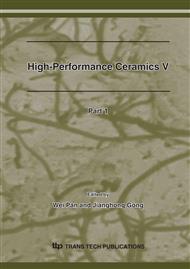p.885
p.888
p.891
p.894
p.898
p.901
p.905
p.908
p.910
Preparation of In Situ Synthesized SiC Particles Reinforced Highly Porous Si3N4 Ceramics by Gel-Casting
Abstract:
In this paper, highly porous Si3N4 ceramics with high strength, homogeneous microstructure were fabricated by introducing a proper amount of nanometer carbon in the Si3N4 slurry by gel-casting. Scanning electron microscopy, X-ray diffraction, Archimedes water-displacement method and three-point bending tests were employed to analyze the microstructures and mechanical properties of the sintered bodies. It was shown by the XRD analysis that SiC particles were formed in the sintered bodies. The pillar β- Si3N4 morphology, homogeneous microstructure and the SiC particles as a reinforcement phase are the contributing factors for high porosity and good mechanical behavior.
Info:
Periodical:
Pages:
898-900
Citation:
Online since:
February 2008
Authors:
Keywords:
Price:
Сopyright:
© 2008 Trans Tech Publications Ltd. All Rights Reserved
Share:
Citation:


